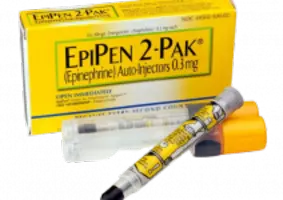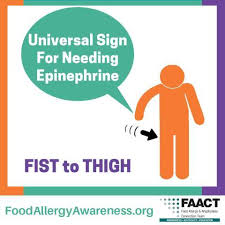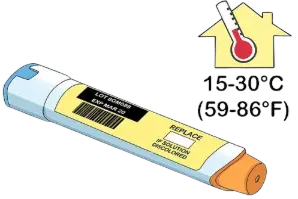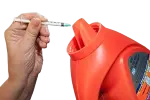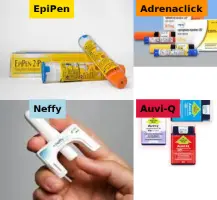
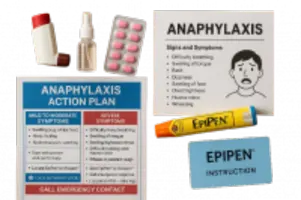
Practical Essential EpiPen Information
Six (6) In-depth curated Topics
Six (6) EpiPen Expert Sites
A curated resource listing authoritative websites and programs related to the EpiPen (epinephrine auto-injectors). It presents six “authority” sources, each with a brief description of what kind of information or service the user can expect. These are:
- EPIPEN® (Official Site) — The manufacturer’s site, with instructions, safety & storage info, prescribing details, and savings/access programs.
- EPIPEN4SCHOOLS® Program — Helps schools get free EPIPEN / EPIPEN JR auto-injectors (or generics), plus training materials and emergency management resources.
- Food Allergy Research & Education (FARE) — Offers comparisons of different brands and options, training, info about generics and new delivery methods (e.g. nasal sprays), aimed at patients/caregivers.
- U.S. Food & Drug Administration (FDA) – Alerts on EpiPen Errors — Safety communications about device malfunctions, user errors, recalls or warnings to watch out for.
- California Department of Education / CA Education Code — Specifically covers how auto-injectors are to be administered in California schools: policies, training of staff, legal obligations, storage, emergency use.
- International Recommendations on Epinephrine Auto-Injectors — A peer-reviewed paper (from PMC / NCBI) looking at international clinical guidelines: differences between countries, weight-based dosing, safety considerations, etc. Useful for comparative or global policy / clinical reference.
What You Need To Know About An EpiPen
Comprehensive introduction to EpiPens (epinephrine auto-injectors) for those who may be new to them. It explains what an EpiPen is, how it works to counteract anaphylaxis, and under what conditions it should be used. Key highlights include identifying symptoms that require epinephrine, understanding the parts of the device (e.g. tip, safety cap, label, etc.), and instructions on how to deliver the injection properly (site, angle, duration). The guide also emphasizes the importance of quickly calling emergency services after use. It touches on who may need one (people with known severe allergies), when to keep one accessible, and how to get one prescribed. Details such as recognizing expiration dates, checking that the solution is clear (not discolored), and the risk of reuse are also covered. Overall, its goal is to relieve fear or confusion by giving clear, authoritative user-friendly advice for parents, caregivers, or anyone who might need to use one in an emergency.
EpiPen Storage
How to properly store an EpiPen so that it remains effective when needed. It outlines temperature ranges for safe storage, typically avoiding extremes of heat or cold (not too hot, not freezing). It explains that exposure to high temperatures or cold can degrade the epinephrine inside, reducing its potency. Also covered are guidelines for keeping the device out of excessive sunlight, moisture, or leaving it in a car where temperature fluctuates. The page recommends checking the clarity of the liquid inside: it should be clear; if discolored or cloudy, it might be compromised. It also advises inspecting the auto-injector regularly to ensure it hasn’t been damaged (cracks, broken safety cap, etc.). In addition, there are suggestions for how and where caregivers or users can store their EpiPens—e.g. in a carrying case, in places they frequent, and ensuring everyone around knows where it is kept. The emphasis is on readiness: having the device stored correctly contributes directly to being able to respond swiftly in an allergic emergency.
Safe Disposal of Used or Expired EpiPens
Outlines why it’s important to dispose of EpiPens safely once they’re used or expired. It starts by explaining the risks associated with improper disposal — leakage, accidental needle-stick injuries, environmental concerns, and ensuring expired epinephrine isn’t accidentally used in an emergency. It describes options for safe disposal: returning the device to your pharmacy, using a sharps container, or following state/local regulations for medical device disposal. It also highlights best practices for temporary storage before disposal (keeping the cap on, storing in a safe, sealed container), so as to avoid injury or contamination. Another section covers checking the expiration date regularly and ensuring that discoloration or cloudiness in the epinephrine solution is a cue that the pen should be discarded. The goal is to provide caregivers, patients, and parents with actionable steps to prevent harms or complications from improperly discarded EpiPens while complying with waste regulations.
U.S.A. FDA-Approved Epinephrine Auto-Injectors
Overview of epinephrine auto-injectors approved by the U.S. Food and Drug Administration (FDA). It lists major brands and models of auto-injectors, their dosing options, device-specific features, and when each is appropriate (for example, based on age or weight of the user). It may compare injection needle size, shape, safety cap designs, shelf life, and cost considerations. Also discussed are regulatory standards for these devices — what the FDA requires in terms of performance, labeling, safety warnings, and manufacturing. There could be guidance for choosing between options (availability, insurance coverage, plans, whether you can get refill prescriptions or generics), plus information about recent recalls or safety notices. The aim is to help people understand what their legal, safe choices are in the U.S., so they can select the auto-injector that best fits their needs, with full awareness of how different models compare.
